
Gotify is a simple server for sending and receiving messages (in real time per WebSocket) like ntfy. With Gotify, you can send notifications to your phone or desktop via scripts, from any computer, without having to sign up or pay any fees. If you’d like to run your own instance of the service, you can easily do so since Gotify is open source. There is also an open source Android app available on Google Play or F-Droid. In this step by step guide I will show you how to install Gotify on your Synology NAS using Docker & Portainer.
This guide works perfectly with the latest Gotify v2.6.3 release.
STEP 1
Please Support My work by Making a Donation.
STEP 2
Install Portainer using my step by step guide. If you already have Portainer installed on your Synology NAS, skip this STEP. Attention: Make sure you have installed the latest Portainer version.
STEP 3
Make sure you have a synology.me Wildcard Certificate. Follow my guide to get a Wildcard Certificate. If you already have a synology.me Wildcard certificate, skip this STEP.
STEP 4
Go to Control Panel / Login Portal / Advanced Tab / click Reverse Proxy. Follow the instructions in the image below.

STEP 5
Now click the “Create” button. Follow the instructions in the image below.
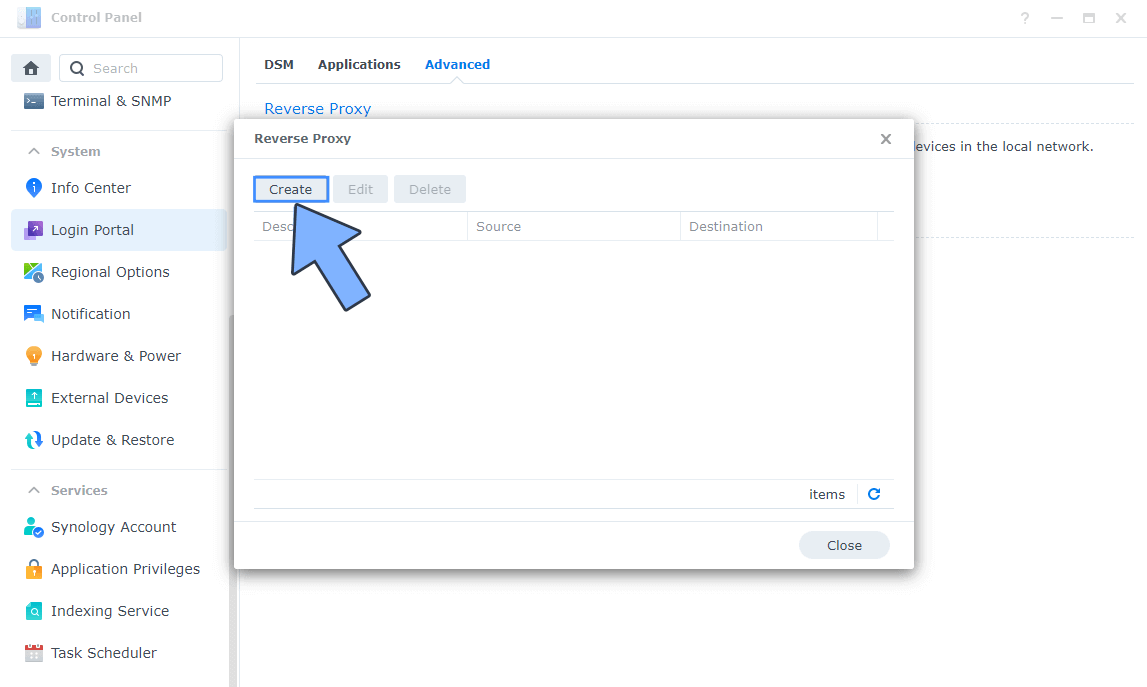
STEP 6
After you click the Create button, the window below will open. Follow the instructions in the image below.
On the General area, set the Reverse Proxy Name description: type in Gotify. After that, add the following instructions:
Source:
Protocol: HTTPS
Hostname: gotify.yourname.synology.me
Port: 443
Check Enable HSTS
Destination:
Protocol: HTTP
Hostname: localhost
Port: 6742
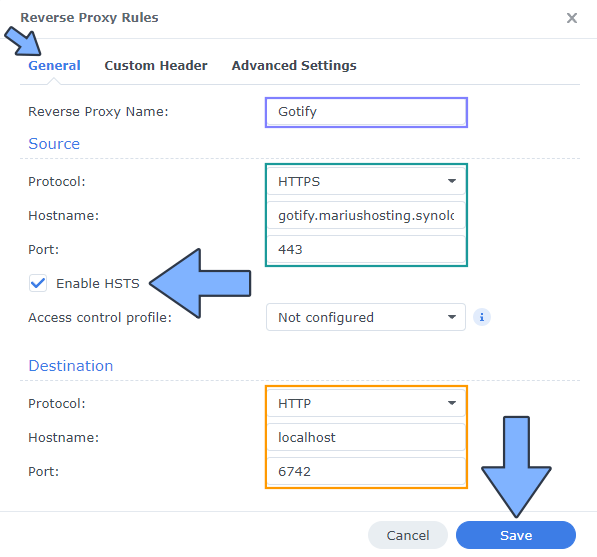
STEP 7
On the Reverse Proxy Rules, click the Custom Header tab. Click Create and then, from the drop-down menu, click WebSocket. After you click on WebSocket, two Header Names and two Values will be automatically added. Click Save. Follow the instructions in the image below.

STEP 8
Go to Control Panel / Network / Connectivity tab/ Check Enable HTTP/2 then click Apply. Follow the instructions in the image below.
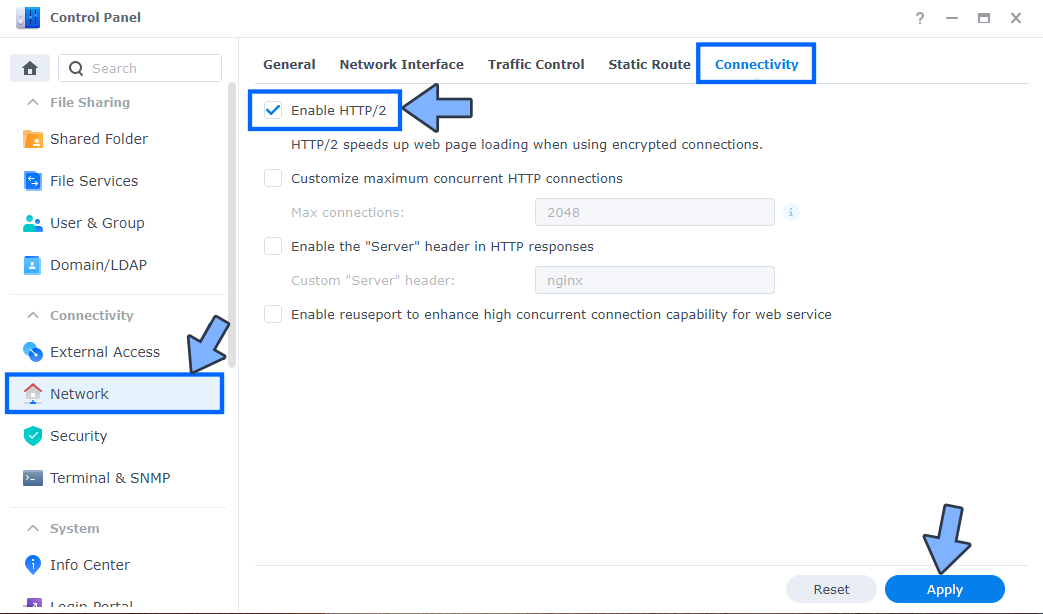
STEP 9
Go to Control Panel / Security / Advanced tab/ Check Enable HTTP Compression then click Apply. Follow the instructions in the image below.
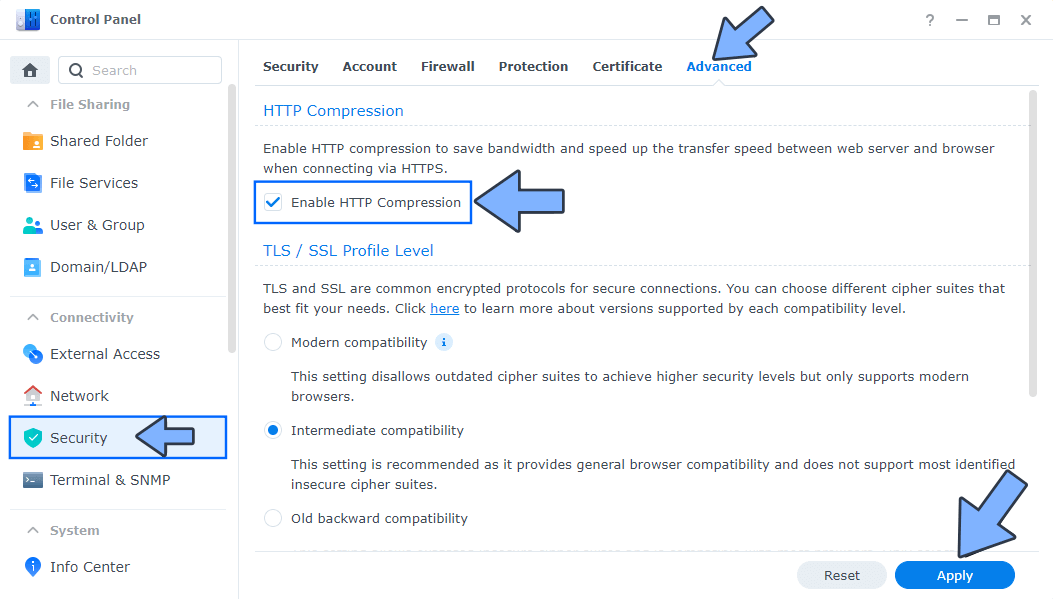
STEP 10
Go to File Station and open the docker folder. Inside the docker folder, create one new folder and name it gotify. Follow the instructions in the image below.
Note: Be careful to enter only lowercase, not uppercase letters.
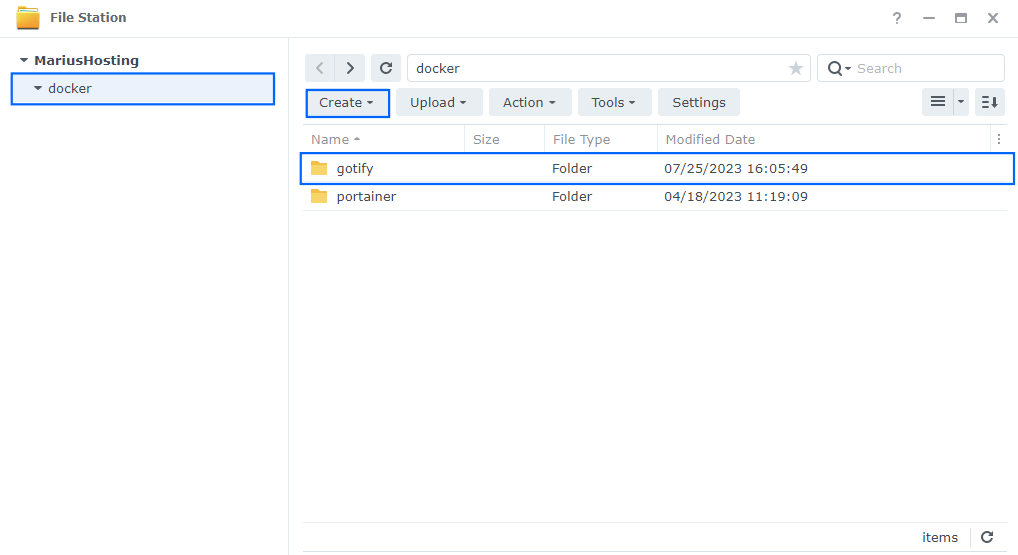
STEP 11
Log into Portainer using your username and password. On the left sidebar in Portainer, click on Home then Live connect. Follow the instructions in the image below.

On the left sidebar in Portainer, click on Stacks then + Add stack. Follow the instructions in the image below.

STEP 12
In the Name field type in gotify. Follow the instructions in the image below.
version: '3.9'
services:
gotify:
image: ghcr.io/gotify/server:latest
container_name: Gotify
restart: on-failure:5
ports:
- 6742:80
volumes:
- /volume1/docker/gotify:/app/data:rw
environment:
GOTIFY_DEFAULTUSER_NAME: marius
GOTIFY_DEFAULTUSER_PASS: mariushosting
TZ: Europe/Bucharest
Note: Before you paste the code above in the Web editor area below, change the value for GOTIFY_DEFAULTUSER_NAME and type in your own username. marius is an example for an username.
Note: Before you paste the code above in the Web editor area below, change the value for GOTIFY_DEFAULTUSER_PASS and type in your own password. mariushosting is an example for a password.
Note: Before you paste the code above in the Web editor area below, change the value for TZ. (Select your current Time Zone from this list.)

STEP 13
Scroll down on the page until you see a button named Deploy the stack. Click on it. Follow the instructions in the image below. The installation process can take up to a few minutes. It will depend on your Internet speed connection.
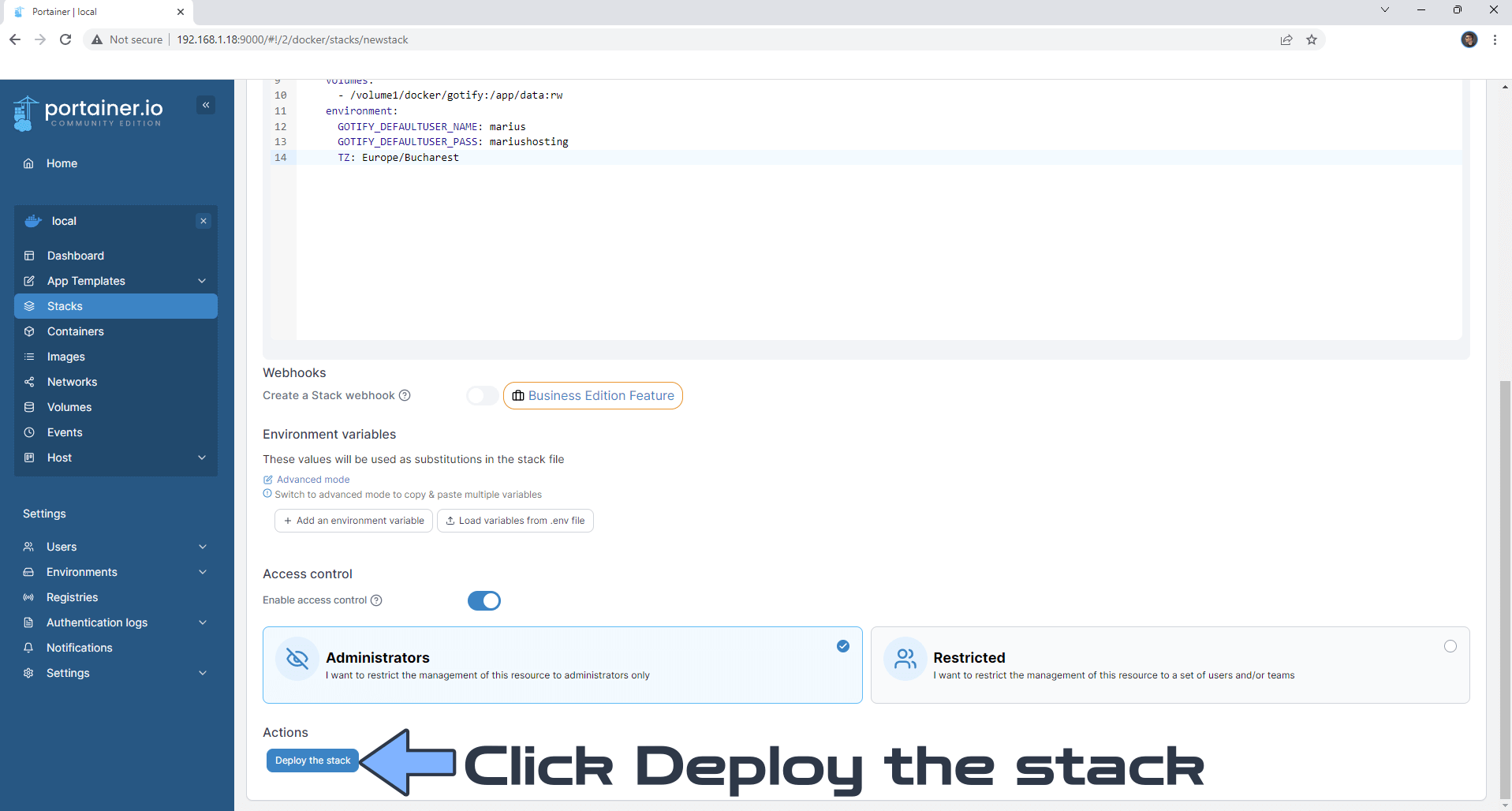
STEP 14
If everything goes right, you will see the following message at the top right of your screen: “Success Stack successfully deployed“.

STEP 15
🟢Please Support My work by Making a Donation. Almost 99,9% of the people that install something using my guides forget to support my work, or just ignore STEP 1. I’ve been very honest about this aspect of my work since the beginning: I don’t run any ADS, I don’t require subscriptions, paid or otherwise, I don’t collect IPs, emails, and I don’t have any referral links from Amazon or other merchants. I also don’t have any POP-UPs or COOKIES. I have repeatedly been told over the years how much I have contributed to the community. It’s something I love doing and have been honest about my passion since the beginning. But I also Need The Community to Support me Back to be able to continue doing this work.
STEP 16
Now open your browser and type in your HTTPS/SSL certificate like this https://gotify.yourname.synology.me In my case it’s https://gotify.mariushosting.synology.me If everything goes right, you will see the the Gotify Login page. Type in your own Username and Password that you have previously added at STEP 12 then click LOGIN. Follow the instructions in the image below.
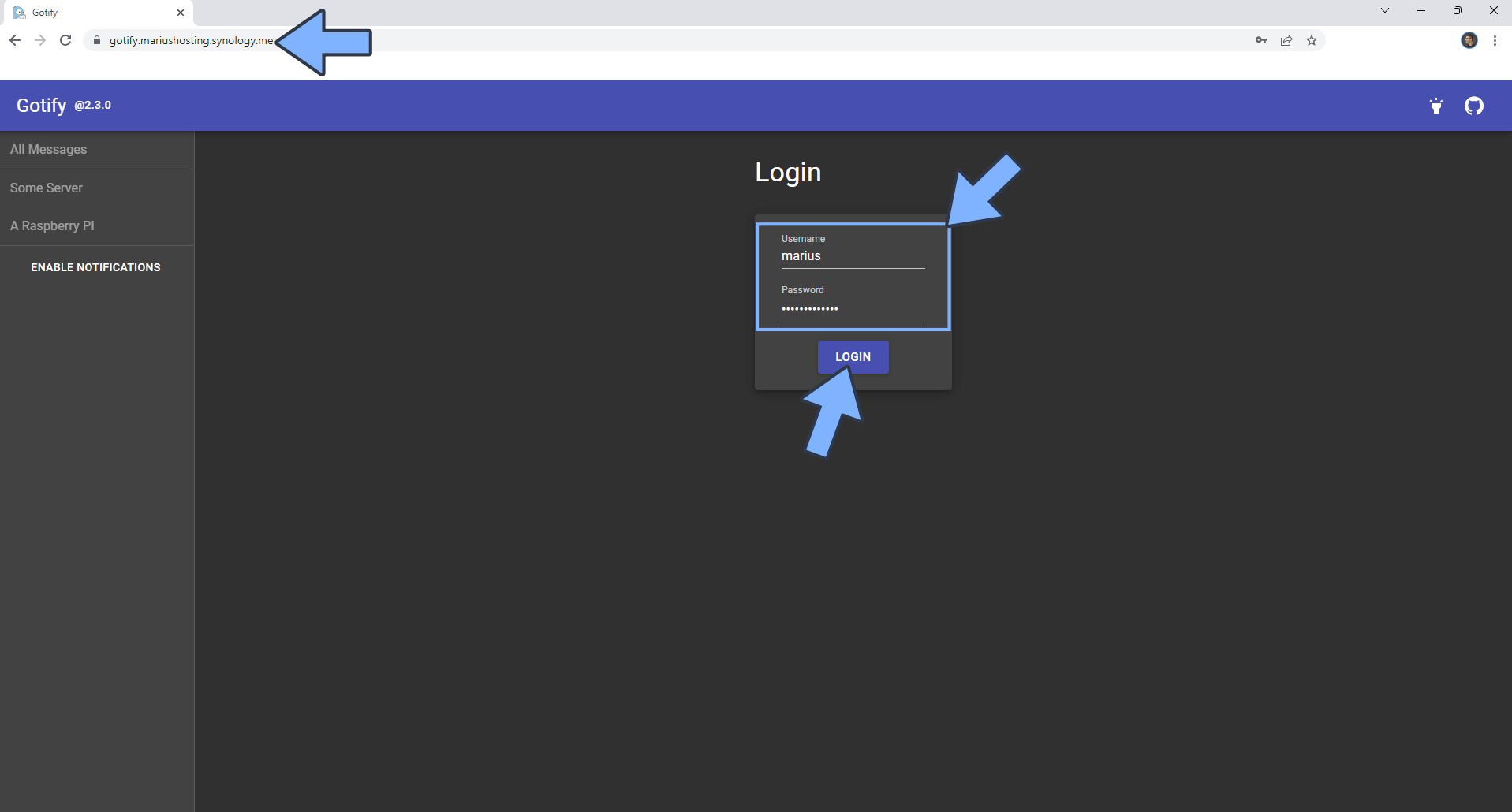
STEP 17
At the top left of the page click ENABLE NOTIFICATIONS. Follow the instructions in the image below.
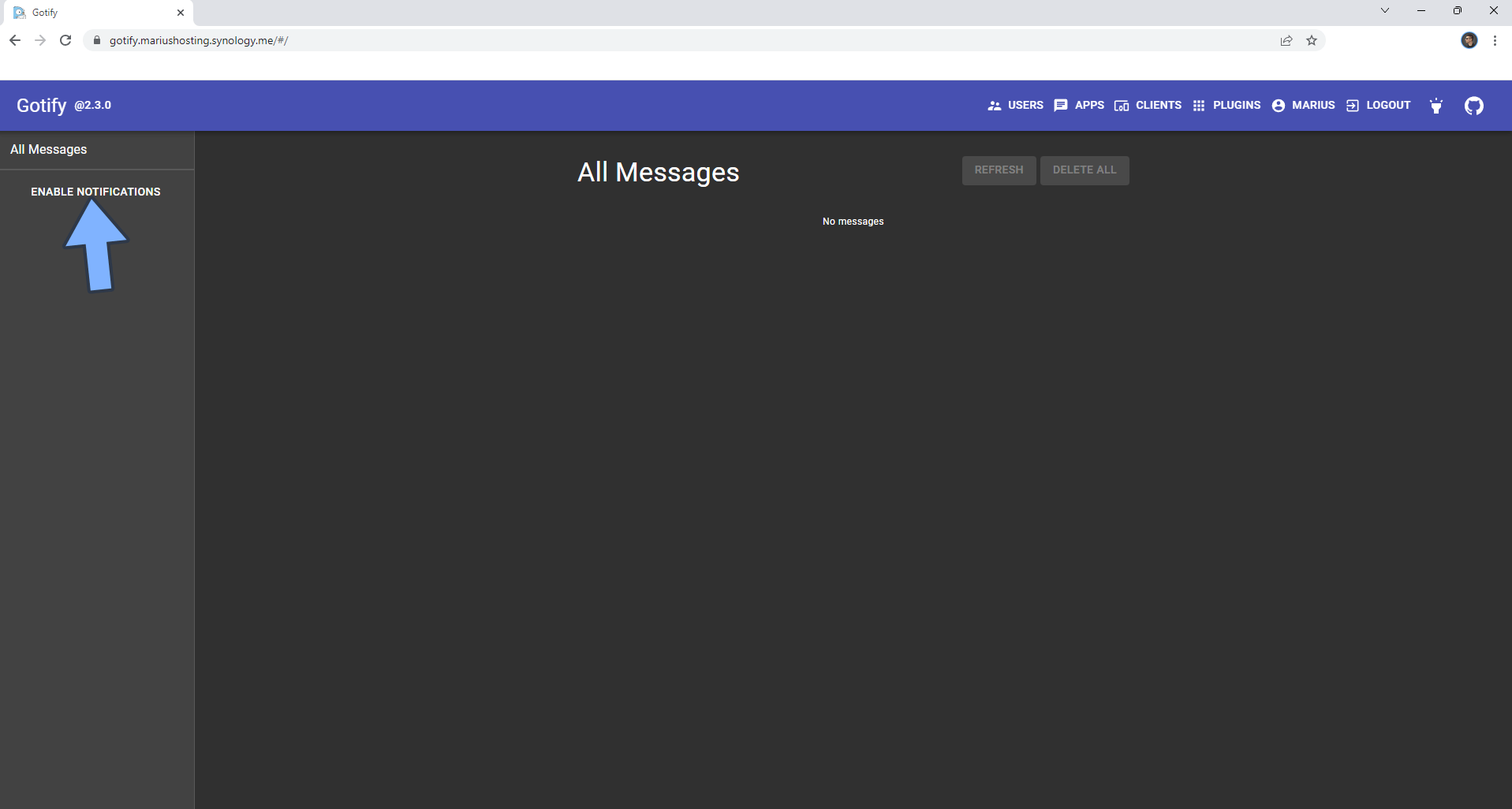
STEP 18
A new pop up window will open. Click Allow. Follow the instructions in the image below.
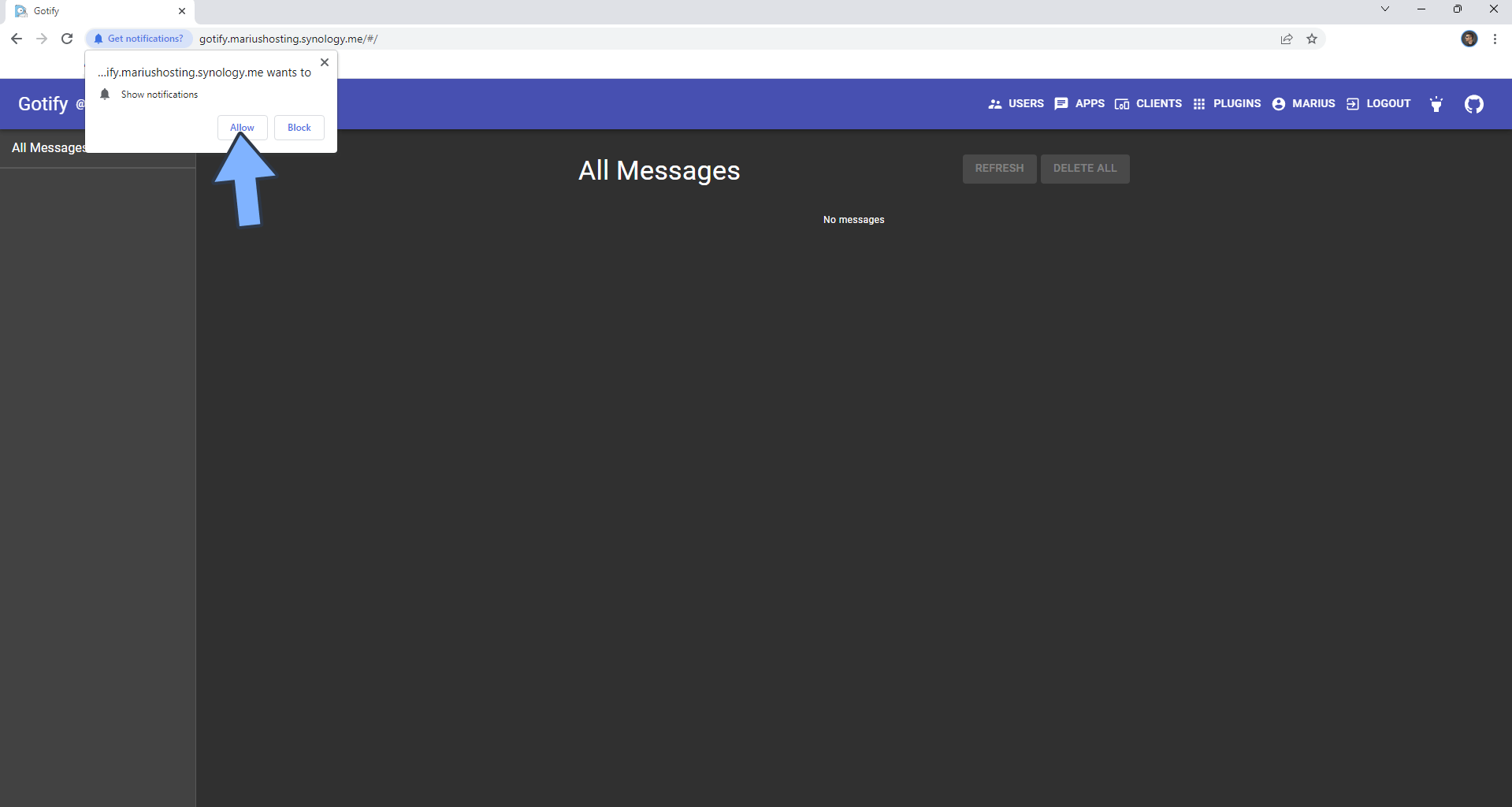
STEP 19
Click the APPS tab, then CREATE APPLICATION. Follow the instructions in the image below.
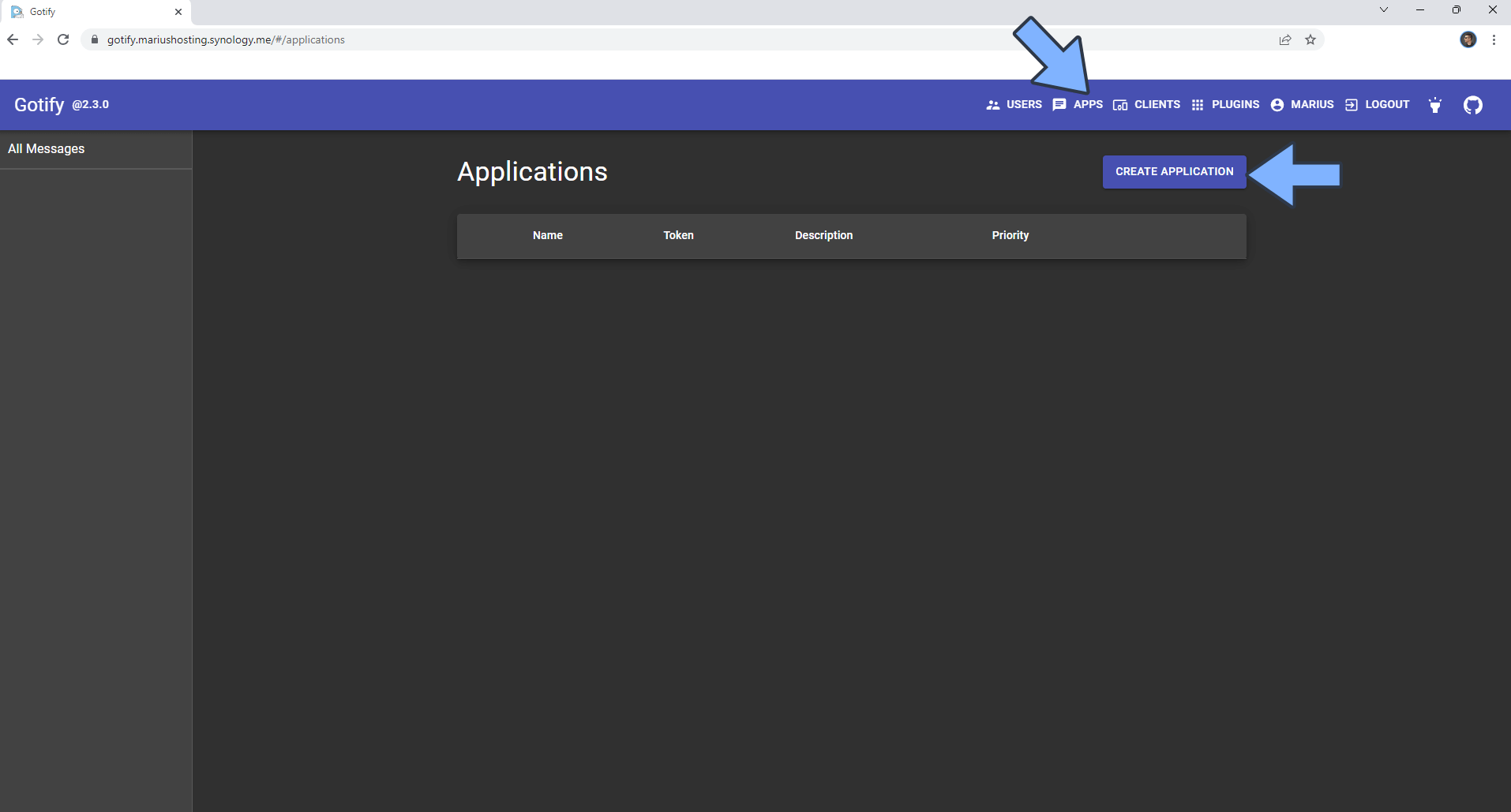
STEP 20
Create an application, for example, Uptime Kuma then click CREATE. Follow the instructions in the image below.
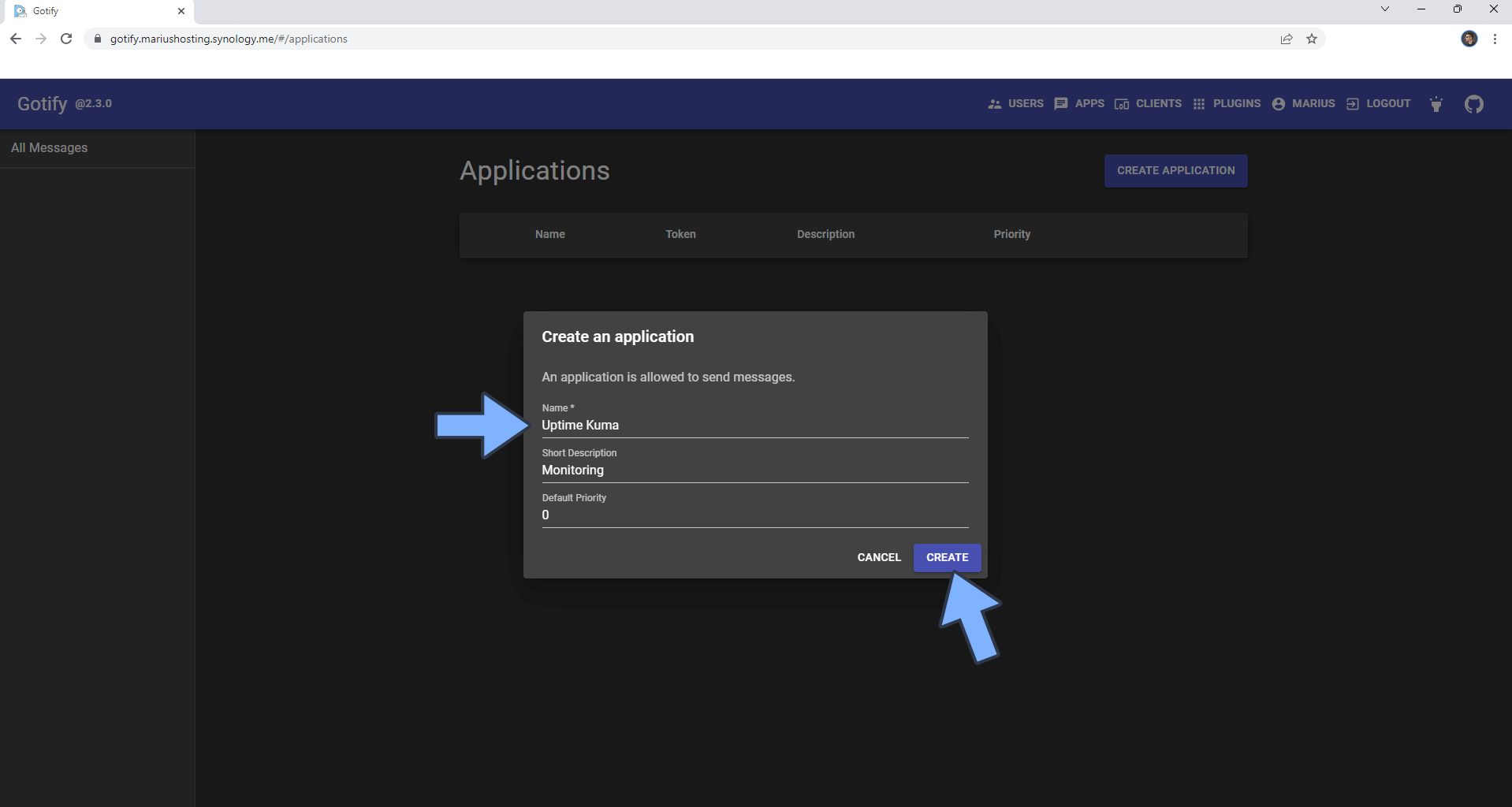
STEP 21
You can upload your own icon. Follow the instructions in the image below.
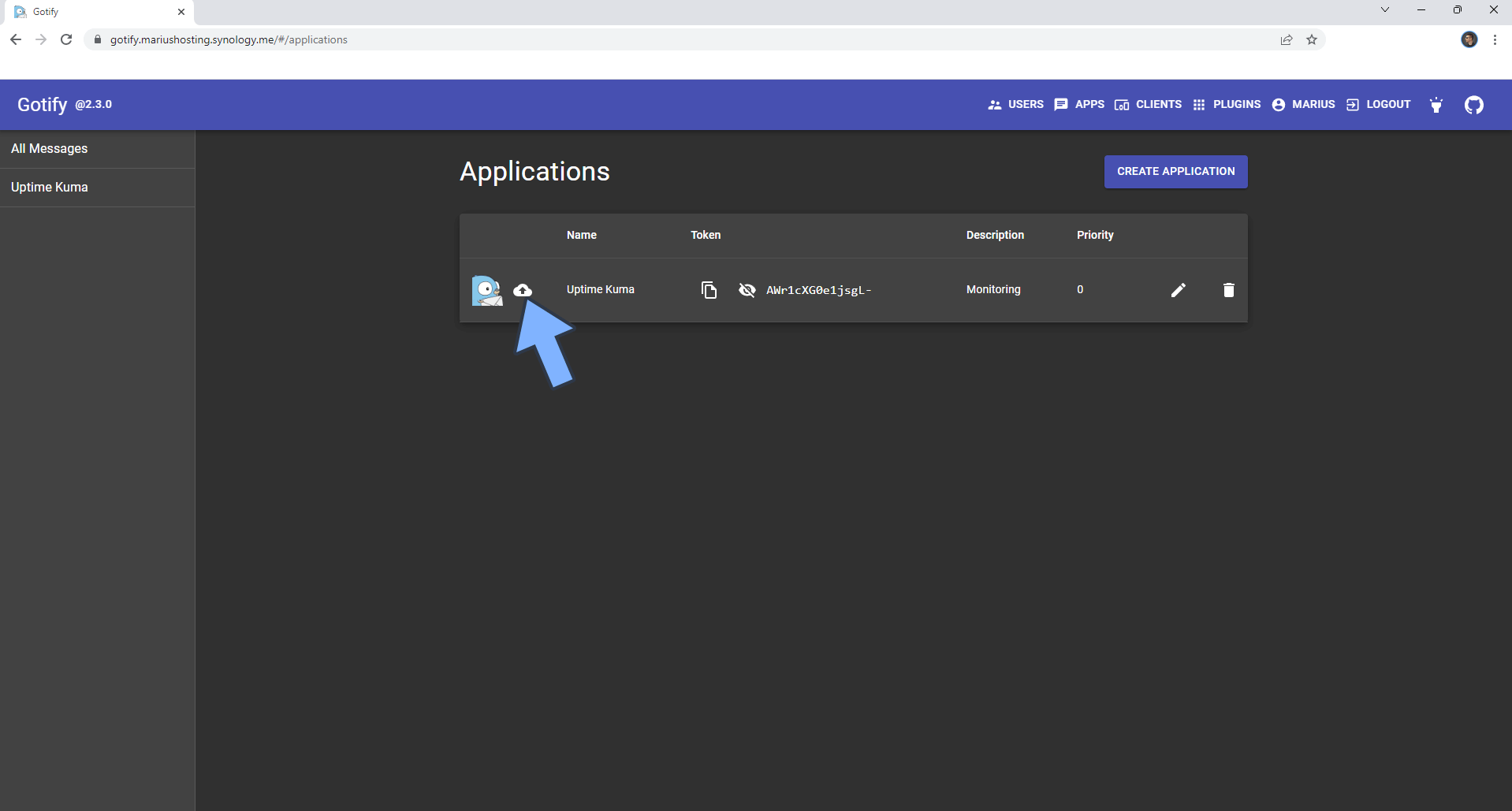
STEP 22
Copy your Token, you will need it later at STEP 24. Follow the instructions in the image below.
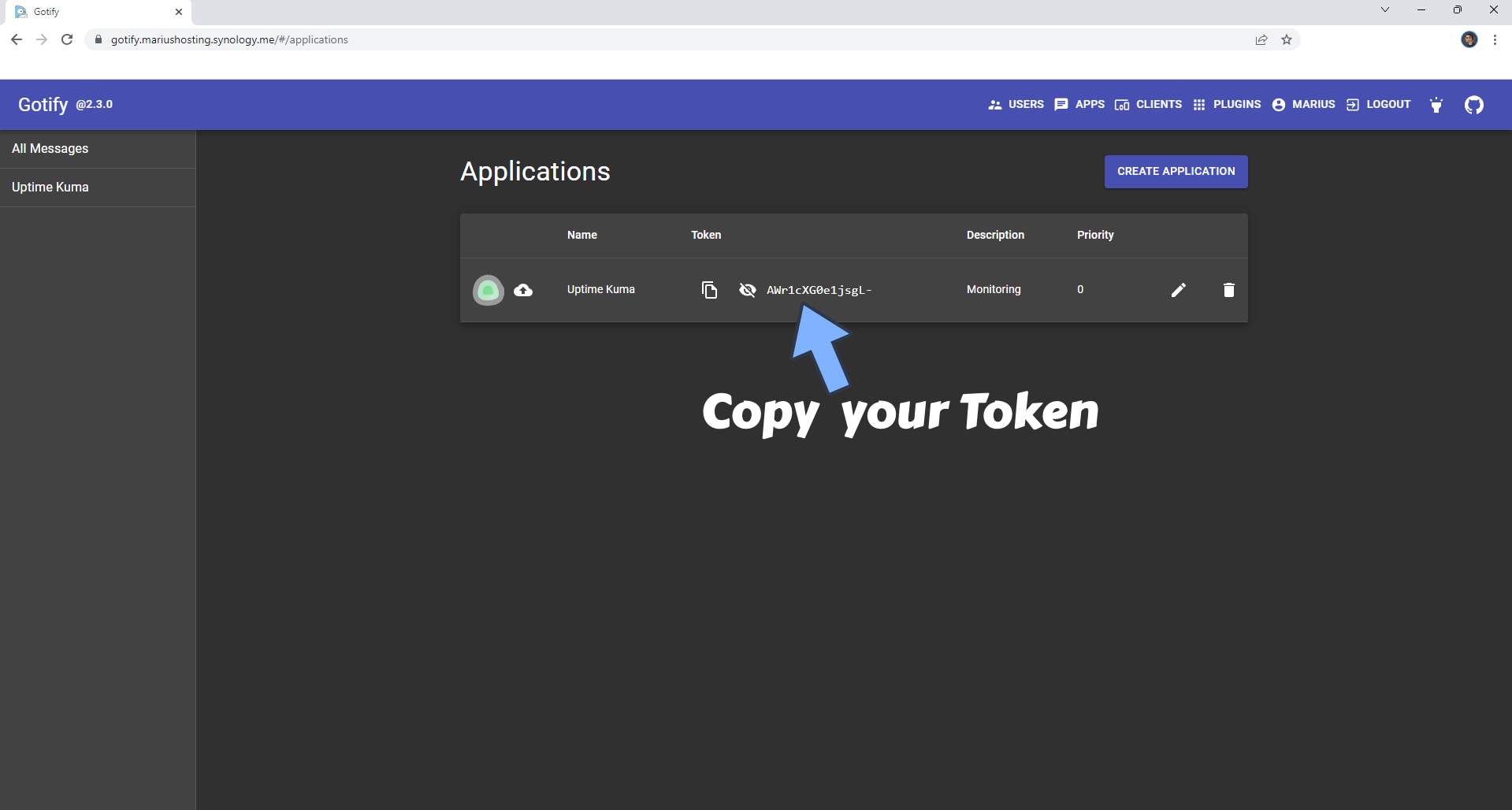
STEP 23
If you have Uptime Kuma installed on your Synology NAS using my easy guide, you can set up Notifications via Gotify. Open Uptime Kuma, then click Settings. Click Notifications, then Setup Notification. Follow the instructions in the image below.
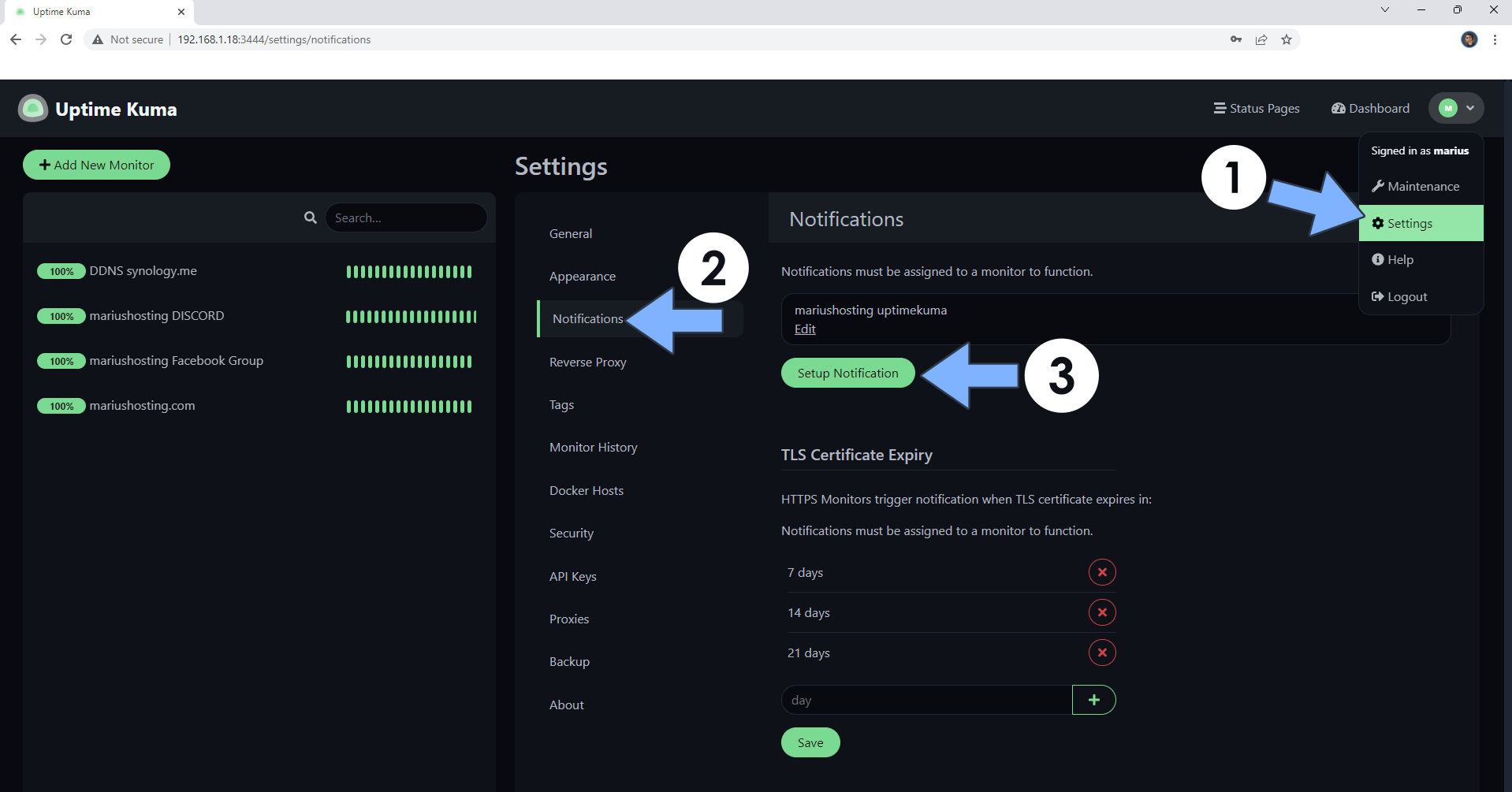
STEP 24
Select Gotify from the Notification list. Choose a friendly name then type in your Token that you have previously generated at STEP 22. Type in your Synology DDNS Gotify link. Click Test then Save. Follow the instructions in the image below.
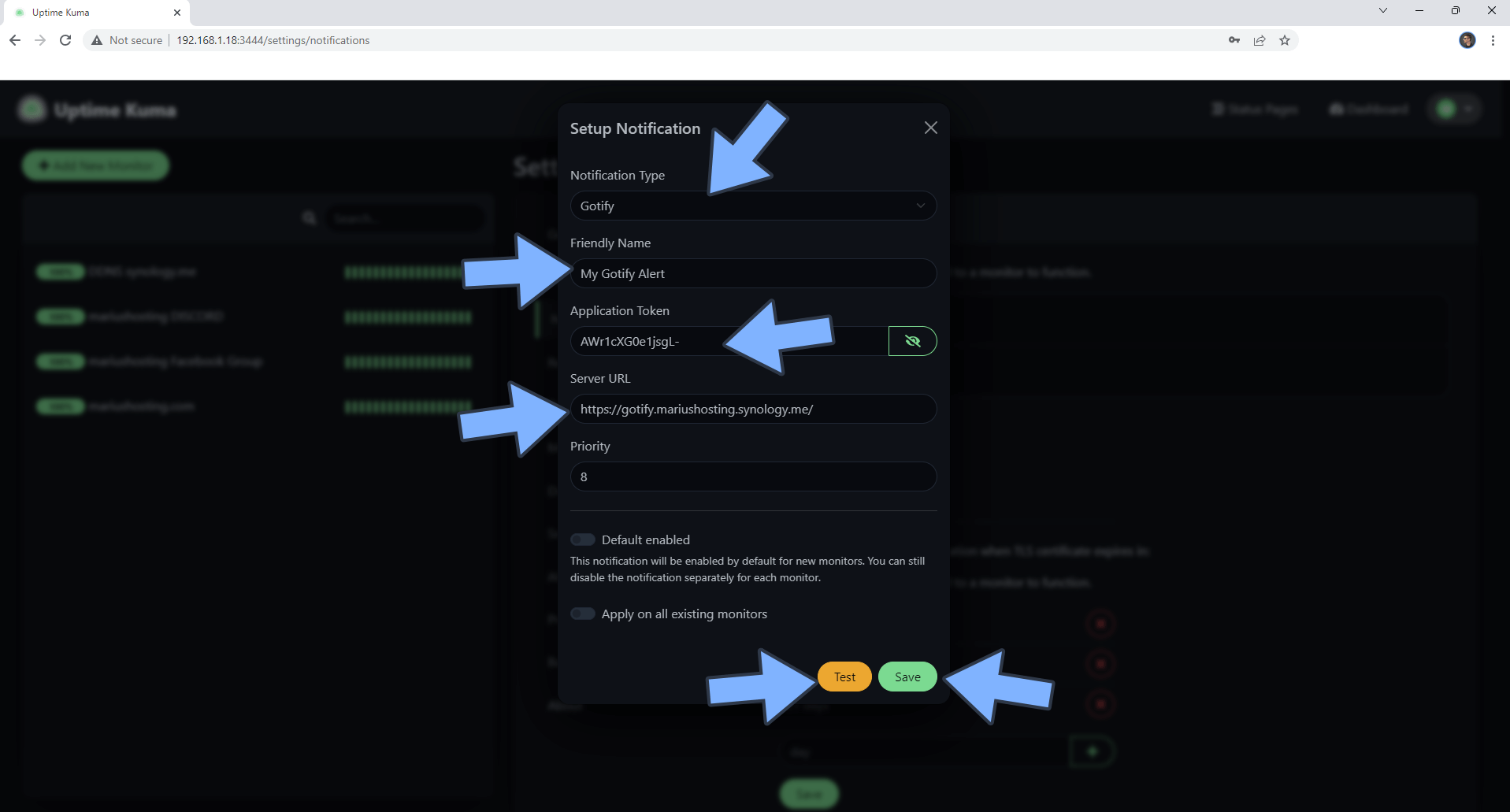
STEP 25
Open Gotify. The Uptime Kuma notifications are now inside your new Gotify Application.

STEP 26
You can also receive notifications from your Synology DSM to your Gotify page. Click the APPS tab, then CREATE APPLICATION. Follow the instructions in the image below.
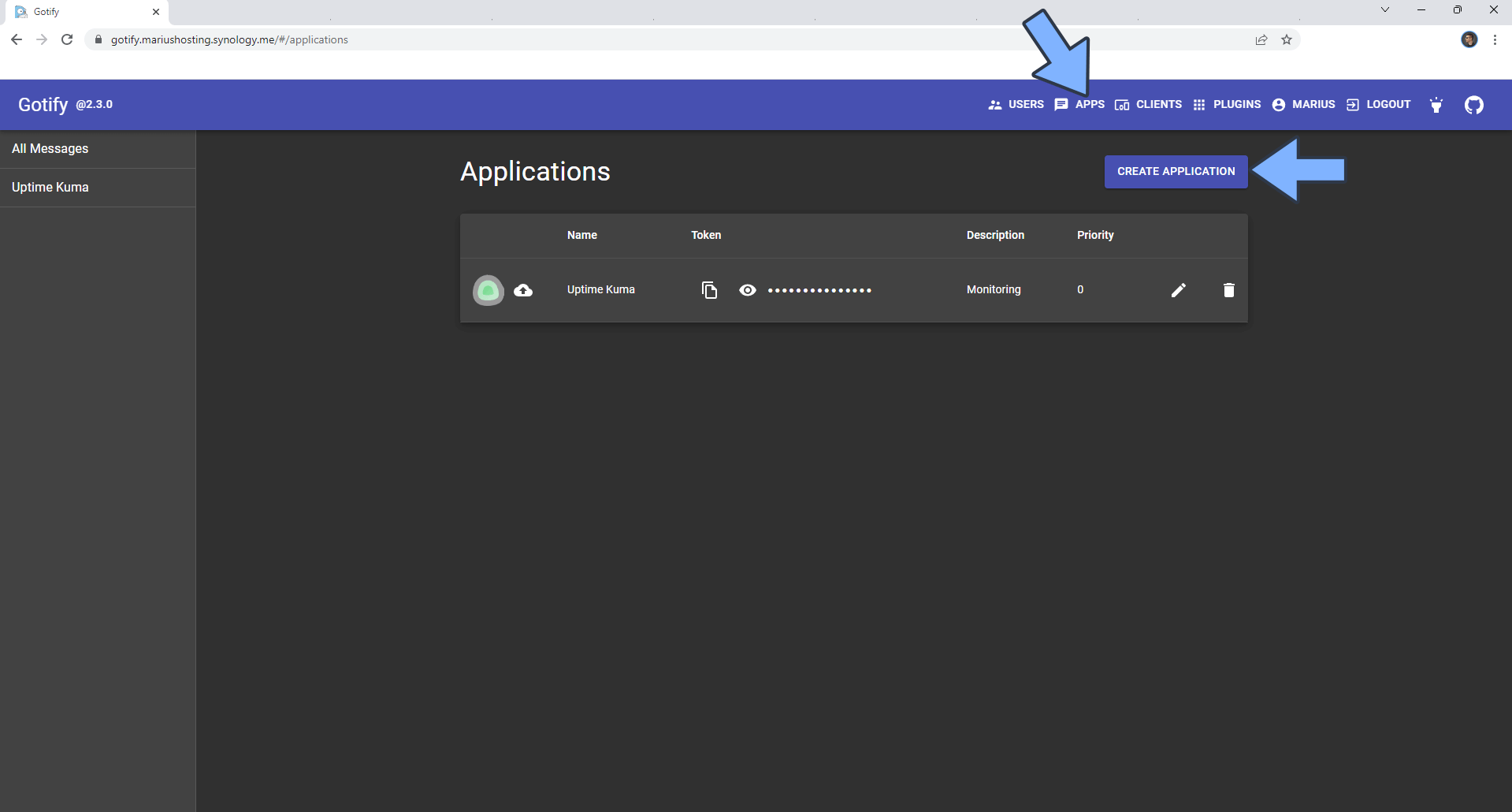
STEP 27
Create an application then name it Synology. Click CREATE. Follow the instructions in the image below.
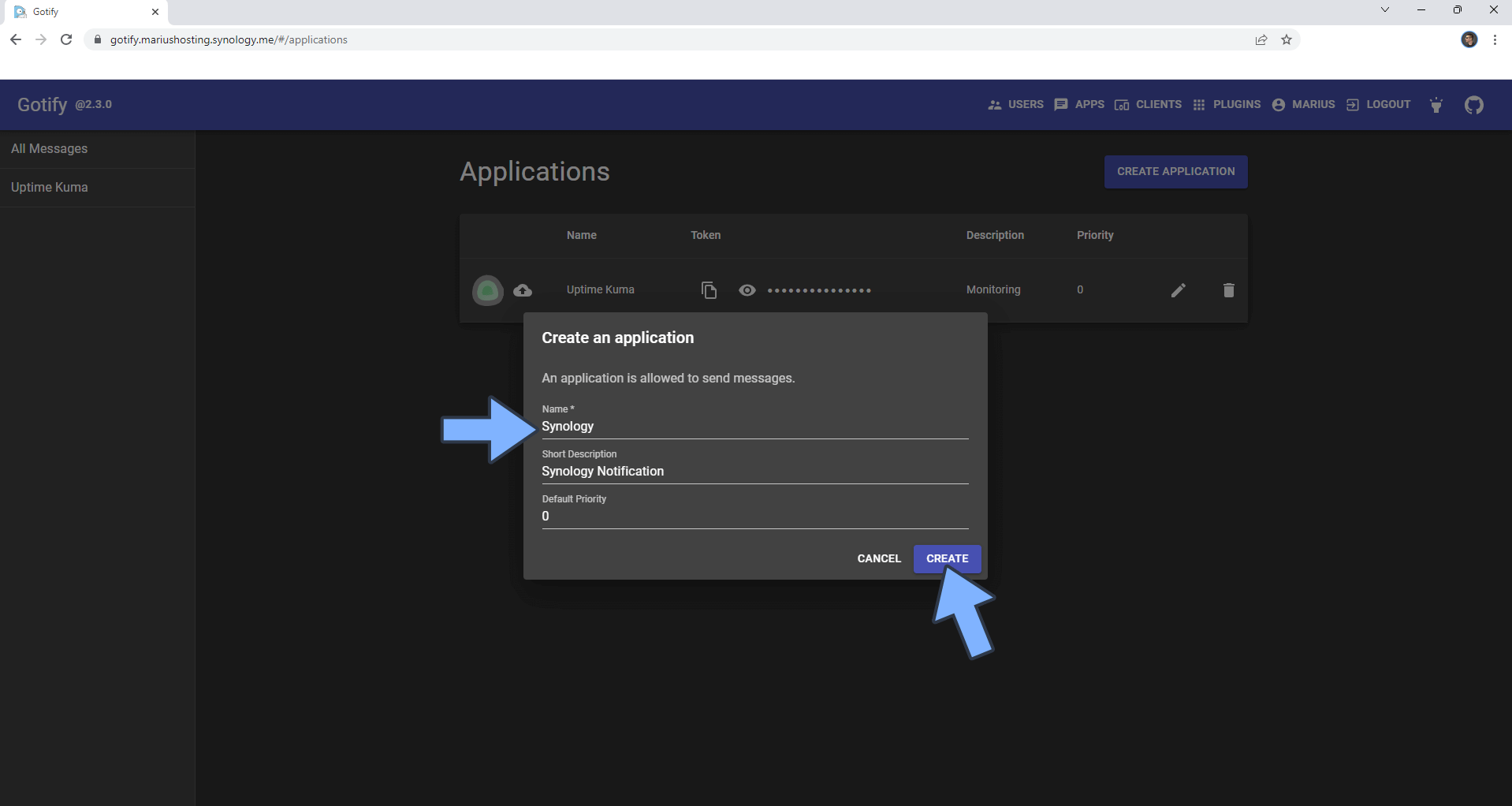
STEP 28
Copy your Token, you will need it later at STEP 24. Follow the instructions in the image below.
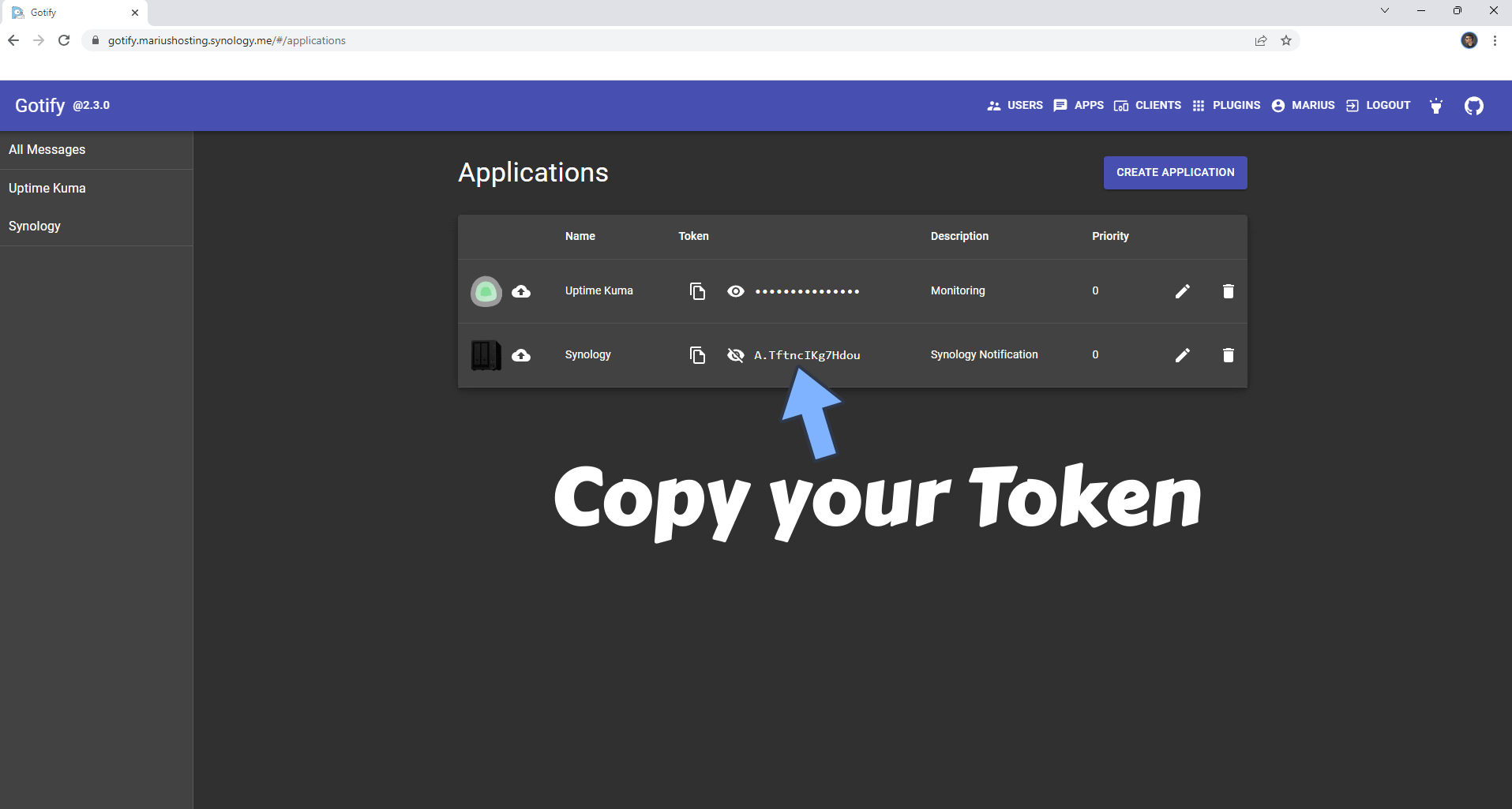
STEP 29
Go to Control Panel / Notifications / Webhooks tab / Click Add. Follow the instructions in the image below.
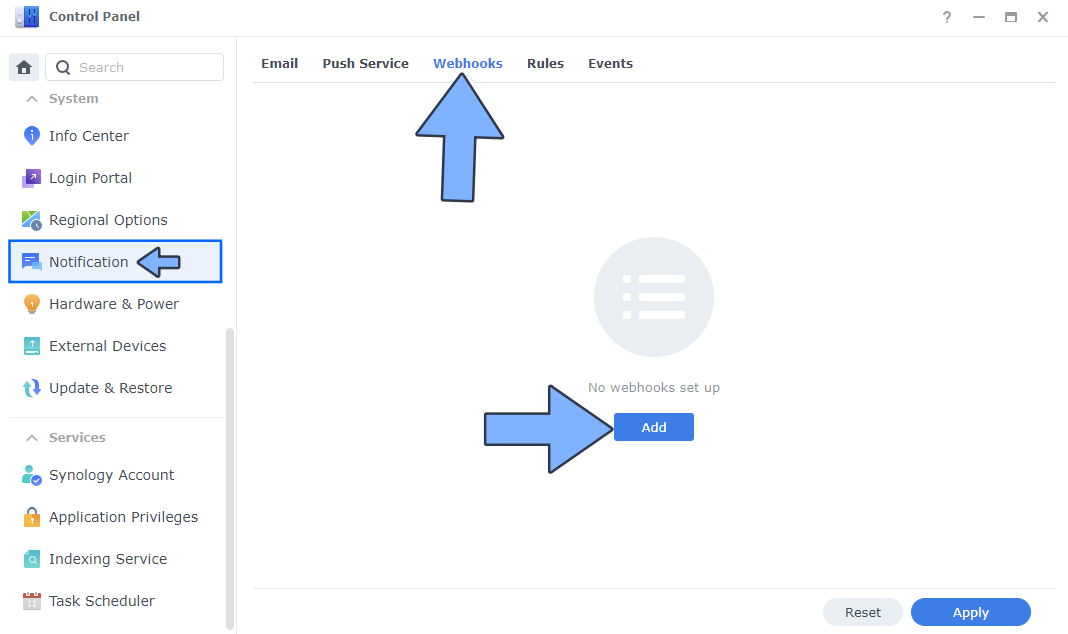
STEP 30
On the Provider area select Custom. On the Rule area select All. Click Next. Follow the instructions in the image below.
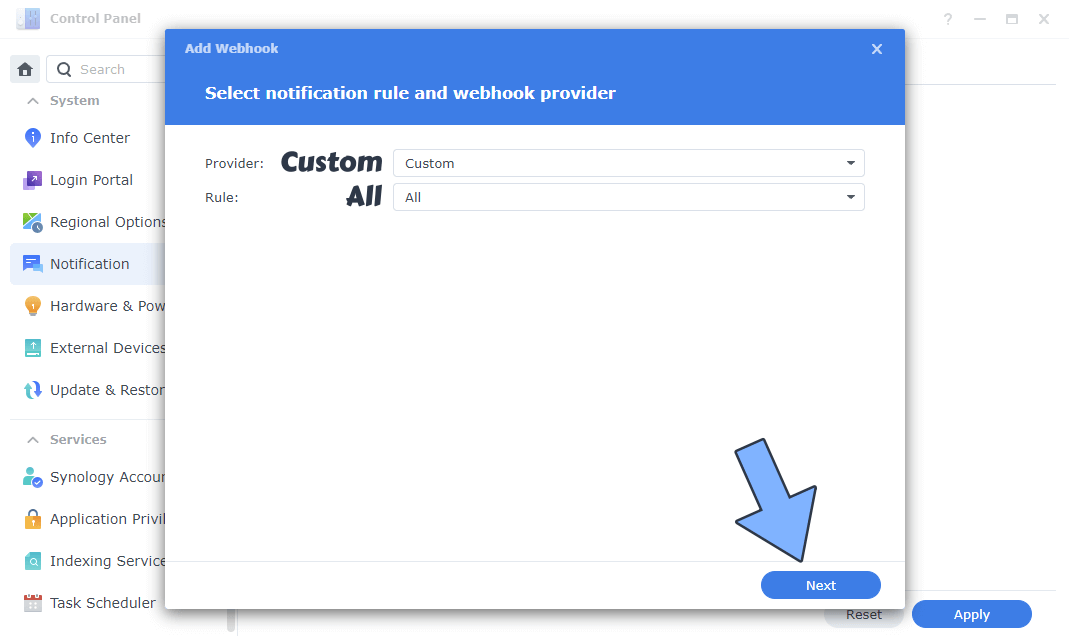
STEP 31
In the Provider name area, type in Gotify. In the Webhook URL area, type in your own Synology DDNS link like in the example below and your own Token that you have previously generated at STEP 28, then click NEXT. Follow the instructions in the image below.
https://gotify.yourname.synology.me/message?token=YourOwnToken
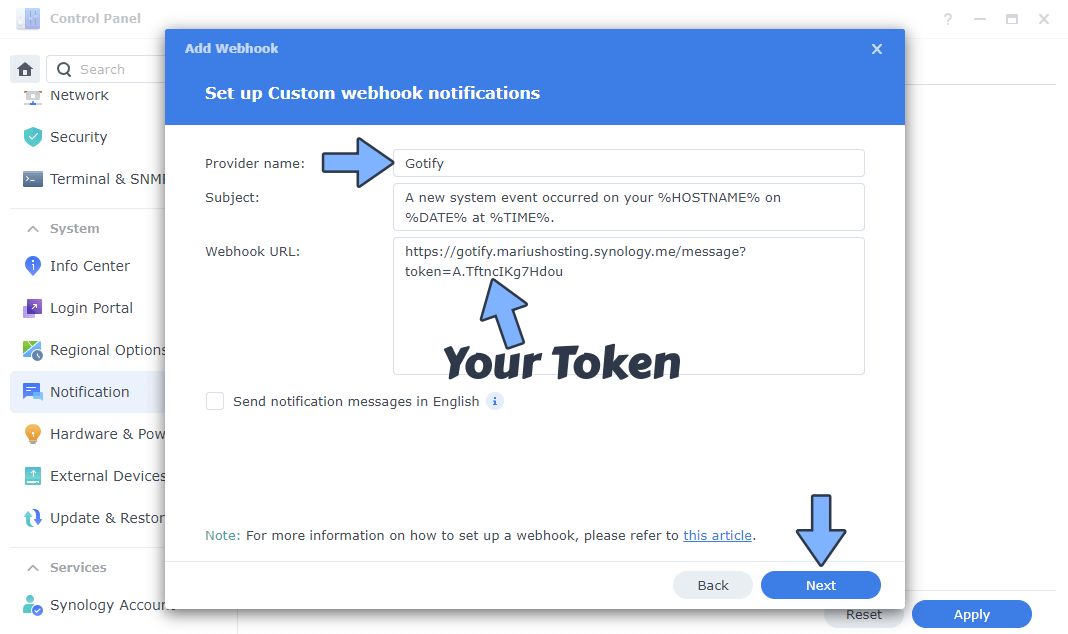
STEP 32
HTTP Method: select POST. Content-Type select application/json. In the HTTP Body area type in the code below, then click Apply. Follow the instructions in the image below.
{
"message": "@@TEXT@@",
"title": "Synology",
"priority": 5,
"extras": {
"client::display": {
"contentType": "text/markdown"
}
}
}
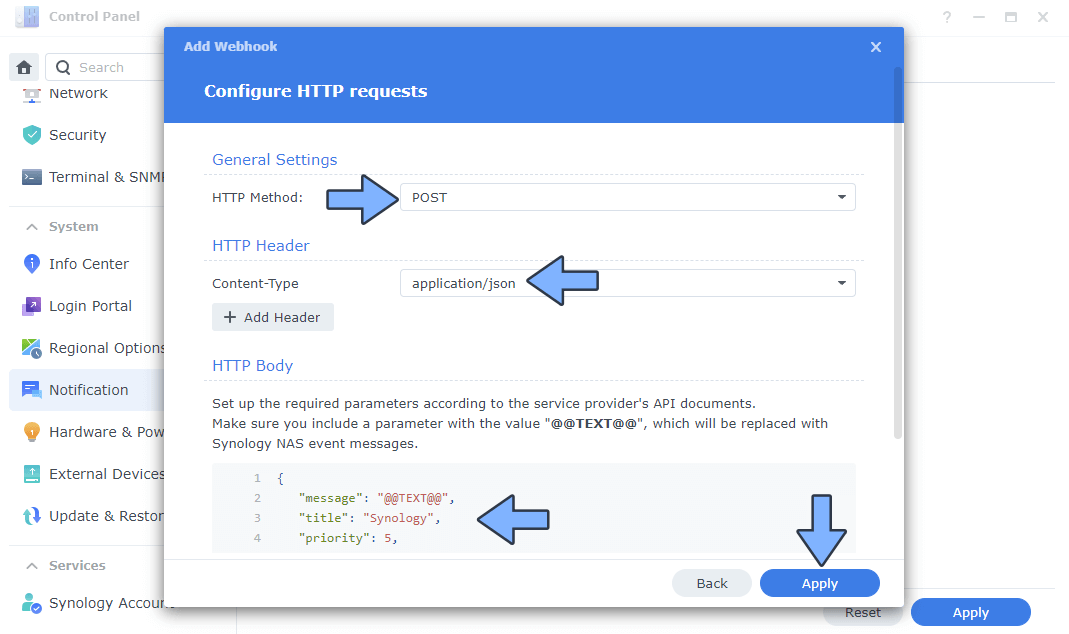
STEP 33
Select your Gotify Provider, then click the Send Test Message tab. Follow the instructions in the image below.
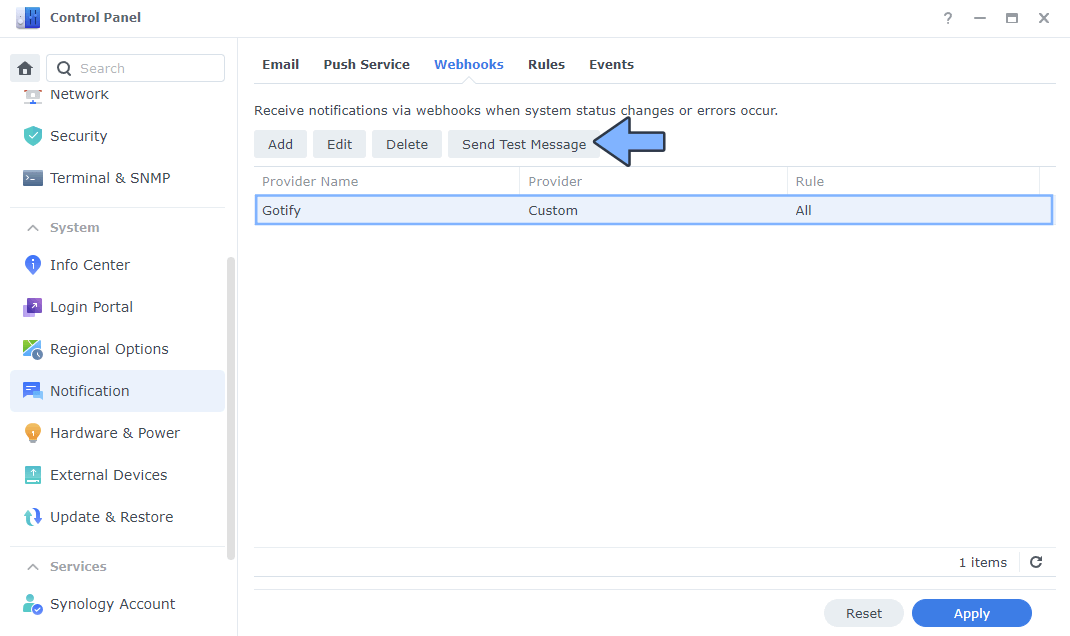
STEP 34
Open Gotify. The Synology DSM notifications are now inside Gotify.

STEP 35
All Notifications on your own Gotify Server at a glance!
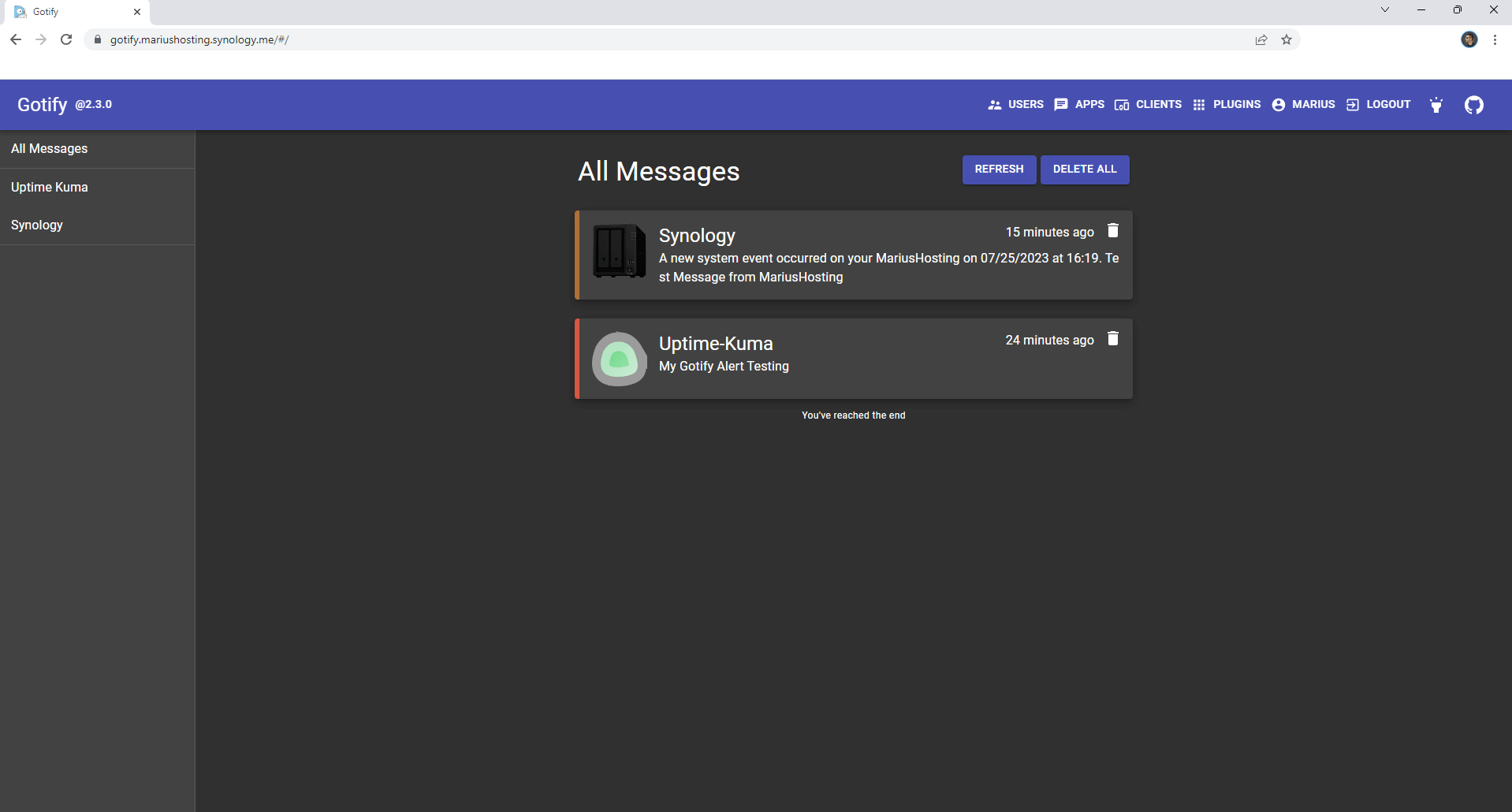
Enjoy Gotify!
If you encounter issues by using this container, make sure to check out the Common Docker issues article.
Note: Can I run Docker on my Synology NAS? See the supported models.
Note: How to Back Up Docker Containers on your Synology NAS.
Note: Find out how to update the Gotify container with the latest image.
Note: How to Free Disk Space on Your NAS if You Run Docker.
Note: How to Schedule Start & Stop For Docker Containers.
Note: How to Activate Email Notifications.
Note: How to Add Access Control Profile on Your NAS.
Note: How to Change Docker Containers Restart Policy.
Note: How to Use Docker Containers With VPN.
Note: Convert Docker Run Into Docker Compose.
Note: How to Clean Docker.
Note: How to Clean Docker Automatically.
Note: Best Practices When Using Docker and DDNS.
Note: Some Docker Containers Need WebSocket.
Note: Find out the Best NAS Models For Docker.
Note: Activate Gmail SMTP For Docker Containers.
This post was updated on Friday / August 29th, 2025 at 6:12 PM
